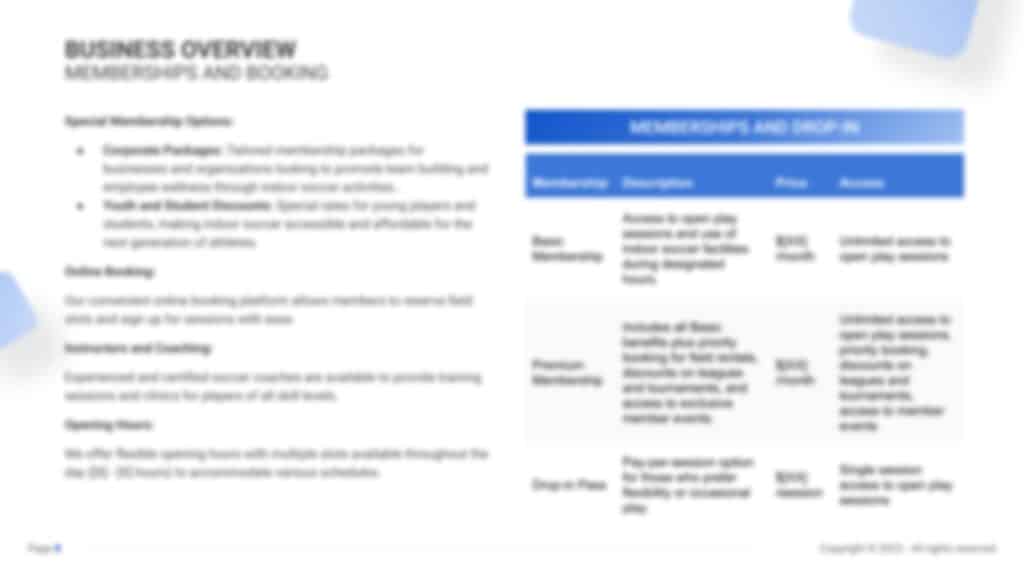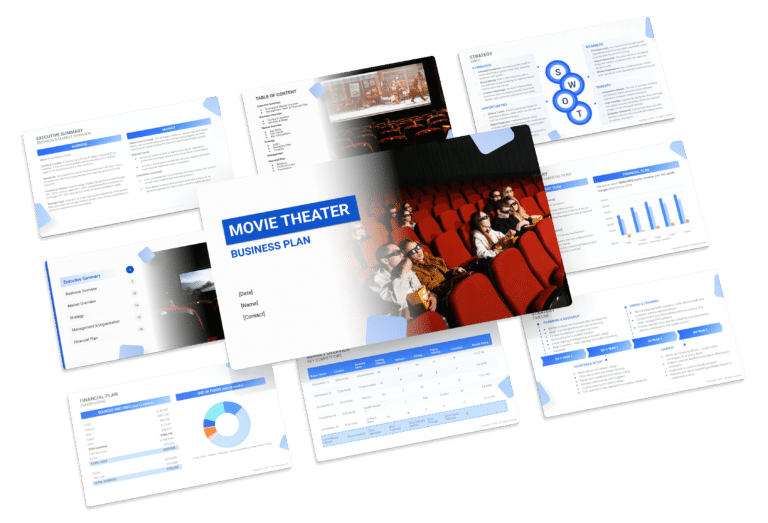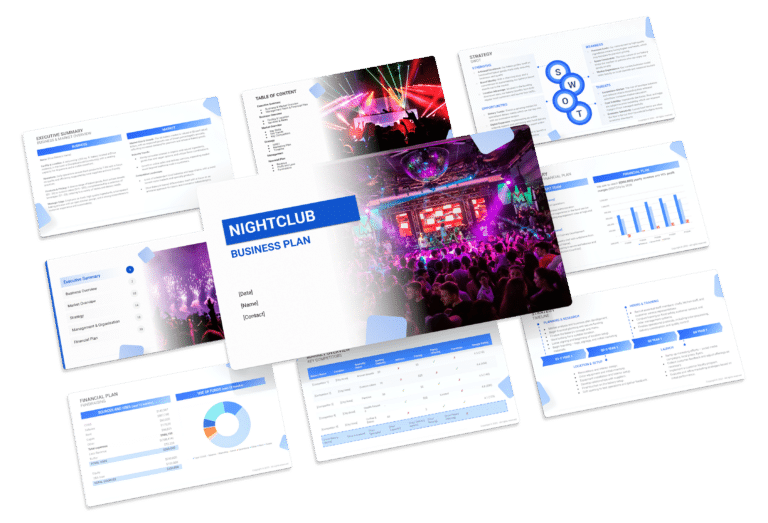Indoor Soccer Business Plan Template & PDF Example

Creating a comprehensive business plan is crucial for launching and running a successful indoor soccer business. This plan serves as your roadmap, detailing your vision, operational strategies, and financial plan. It helps establish your indoor soccer business’s identity, navigate the competitive market, and secure funding for growth.
This article not only breaks down the critical components of an indoor soccer business plan, but also provides an example of a business plan to help you craft your own.
Whether you’re an experienced entrepreneur or new to the recreation industry, this guide, complete with a business plan example, lays the groundwork for turning your indoor soccer business concept into reality. Let’s dive in!
The Plan
Our Indoor Soccer business plan is designed to comprehensively cover all essential elements required for a well-rounded strategic approach. It details the operational structure, marketing strategies, market dynamics, competitive landscape, management team, and financial projections for the indoor soccer facility.
- Executive Summary: Provides a snapshot of our Indoor Soccer facility’s business idea, market study, team leadership, and financial approach.
- Business Overview: Details what our Indoor Soccer facility offers and how it functions:
- Facility & Location: Discusses the facility’s layout, features, and why its location is beneficial for soccer enthusiasts.
- Membership & Booking: Outlines the types of memberships available, booking process, and additional services like coaching and equipment rental.
- Market Overview: Looks into the indoor soccer market, pinpointing competitors and our facility’s unique aspects:
- Key Stats: Offers data on the indoor soccer market size, growth trends, and important figures.
- Key Trends: Points out emerging trends in indoor soccer and recreational sports.
- Key Competitors: Evaluates nearby indoor soccer facilities and what sets ours apart.
- Strategy: Lays out our approach to growing the business and attracting soccer players:
- SWOT: Analysis of strengths, weaknesses, opportunities, and threats.
- Marketing Plan: Tactics for promoting the facility and keeping members engaged.
- Timeline: Important steps and goals from the opening to the end of the first year.
- Management: Shares info about the people running the Indoor Soccer facility and their roles.
- Financial Plan: Forecasts our facility’s financial outcomes over five years, including income, profits, and costs.

Executive Summary
The Executive Summary introduces your indoor soccer facility’s business plan, providing a succinct overview of your venue and its offerings. It should outline your market positioning, the variety of indoor soccer services and related activities you offer, its location, dimensions, and a brief on daily operations.
This section should also delve into how your indoor soccer business will carve its niche in the local market, including an analysis of direct competitors in the vicinity, identifying who they are, along with your facility’s unique selling points that set it apart from these competitors.
Moreover, it’s important to include information about the management and co-founding team, outlining their roles and how their expertise will contribute to the facility’s success.
Additionally, a summary of your financial projections, including anticipated revenue and profits over the next five years, should be included to offer a clear view of your indoor soccer business’s financial outlook.
Indoor Soccer Business Plan Executive Summary Example


Business Overview
Your executive summary’s business overview should clearly present essential details about your indoor soccer facility, including the business name, location, and a summary of operations. This section is key to introducing your business and highlighting what sets it apart from the competition.
Your unique selling proposition (USP) is crucial for differentiating your indoor soccer facility from others. This could be your state-of-the-art equipment, exceptional coaching staff, or innovative membership packages. The USP should capture the interest of your target audience and demonstrate the unique value your business offers to the soccer community.
Example:
“Indoor Soccer Haven” is strategically located in the heart of City Central, encompassing a 20,000 sq. ft. area equipped with professional-grade indoor soccer fields and top-tier artificial turf. Our facility stands out by offering flexible booking through a user-friendly online platform, comprehensive training programs led by certified coaches, and diverse membership options catering to various community segments, including corporate groups and students.
Market Overview
The market overview should outline the size, growth trends, and dynamics of the indoor soccer facility industry. Highlight the industry’s current growth phase, participant numbers, and key market trends that could impact your business, such as digital integration and a focus on health and safety protocols.
Discuss the competitive landscape, pinpointing major competitors and describing how your indoor soccer facility distinguishes itself in this environment. This could be through superior facilities, unique programming, or community engagement initiatives.
Example:
With over 3,400 soccer fields nationwide and 5.2 million participants, the indoor soccer industry in the US is thriving. “Indoor Soccer Haven” faces competition from both specialized indoor arenas and multipurpose sports complexes within a 10-mile radius. However, our emphasis on high-quality facilities, advanced performance tracking, and a broad range of inclusive programs sets us apart, catering to a growing demand for specialized indoor soccer experiences.
Management Team
The expertise and background of your management team are invaluable to your business. Highlight the key qualifications and experiences of team members, such as a manager’s extensive background in sports management or a coach’s professional soccer experience.
This section should build credibility and assure potential investors of your indoor soccer business’s capability to succeed.
Example:
“Indoor Soccer Haven” is led by founders Jordan Ellis and Taylor Kim. Jordan, with a Master’s in Sports Management, brings strategic oversight and a passion for soccer, while Taylor, a former professional soccer player, oversees operations, ensuring top-notch player experiences and high safety standards.
Financial Plan
Your financial plan should succinctly outline financial goals and projections, such as revenue targets and profit margins, providing a clear picture of your indoor soccer business’s financial future.
Example:
“Indoor Soccer Haven” targets $880,000 in annual revenue with a 15% EBITDA margin by 2028. Our strategy includes scaling up through strategic marketing, community engagement, and hosting tournaments and events, driving membership growth and increasing utilization rates, positioning us for profitability and a leading role in the indoor soccer community.
Business Overview
For an Indoor Soccer Business, the Business Overview section can be efficiently divided into 2 main slides:
Facility & Location
Briefly describe the facility’s physical setup, emphasizing its design, functionality, and the engaging atmosphere it provides for players and spectators.
Mention the facility’s location, highlighting its accessibility and the convenience it offers, such as proximity to community centers or ease of parking. Explain why this location is strategically chosen to attract your target clientele, which may include soccer enthusiasts, local leagues, and families looking for recreational activities.
Membership & Booking
Detail the range of services and activities offered, from casual pick-up games and league tournaments to soccer clinics and private coaching sessions.
Outline your pricing strategy, ensuring it reflects the value of the facilities and services provided and aligns with the market you’re targeting. Highlight any membership options, online booking capabilities, or loyalty programs that provide added value to your customers, encouraging consistent engagement and community loyalty.


Market Overview

Industry size & growth
In the Market Overview of your indoor soccer business plan, begin by examining the size of the sports facility industry, specifically focusing on indoor soccer, and its growth potential. This analysis is essential for grasping the market’s breadth and identifying opportunities for expansion.
Key market trends
Continue by discussing recent market trends, such as the growing interest in community and recreational sports, the rise of youth and adult soccer leagues, and the increasing demand for year-round training facilities due to unpredictable weather conditions. For instance, highlight the demand for facilities that offer not just playing space but also training programs, events, and tournaments, alongside the rising popularity of health and fitness activities.
Competitive Landscape
A competitive analysis is not just a tool for gauging the position of your indoor soccer business in the market and its key competitors; it’s also a fundamental component of your business plan.
This analysis helps in identifying your indoor soccer’s unique selling points, essential for differentiating your business in a competitive market.
In addition, competitive analysis is integral to laying a solid foundation for your business plan. By examining various operational aspects of your competitors, you gain valuable information that ensures your business plan is robust, informed, and tailored to succeed in the current market environment.
Identifying Your Competitors in the Indoor Soccer Industry
The initial step in conducting a competitive analysis is to identify who your competitors are. Start by listing local indoor soccer facilities and sports complexes that offer soccer.
If your business is focused on providing high-quality turf and advanced training programs, your direct competitors include other indoor soccer facilities that promote similar offerings, as well as larger sports complexes that may offer a variety of sports including soccer. It’s important not to forget about indirect competitors such as outdoor soccer leagues or other sports facilities that might attract your target audience.
Utilize online tools such as Google Maps to understand the geographical spread of these competitors. Platforms like Yelp and TripAdvisor can provide customer reviews and ratings, offering a window into the strengths and weaknesses of your competitors. For example, if a number of reviews highlight the state-of-the-art equipment and friendly staff at “Premier Indoor Soccer,” this indicates a strong competitor.

Indoor Soccer Competitors’ Strategies
Understanding the strategies of your competitors encompasses several areas:
- Facilities and Amenities: Review the quality and range of facilities provided. If “City Soccer Arena” is popular for its high-end turf and player lounges, this indicates a trend towards premium indoor soccer experiences.
- Training Programs: Look into the training programs they offer. A facility known as “Youth Soccer Academy” that specializes in youth development programs might cater to a different segment than one that offers adult leagues and casual play.
- Pricing Structure: Examine how your fees compare with those of your competitors. Are your membership plans and drop-in rates competitive with those of “Affordable Soccer Complex,” or do they align more with upscale facilities like “Elite Soccer Club”?
- Marketing Strategies: Observe how competitors market their facilities and programs. Do they have a robust online presence, or do they focus on partnerships with local schools and community organizations?
- Customer Experience: Evaluate the overall customer experience. A facility like “Community Soccer Hub” might be renowned for its welcoming environment and community events, which can enhance customer loyalty.
- Operational Efficiencies: Note if competitors are leveraging technology or innovative practices to improve booking, scheduling, and customer management, similar to “SoccerTech Center” with its user-friendly app.
What’s Your Indoor Soccer Business’s Value Proposition
Reflect on what makes your indoor soccer business stand out. Perhaps you offer exclusive training clinics with professional players, or maybe your facility includes amenities like a café and pro shop that aren’t found elsewhere in your area.
Identify potential market opportunities through customer feedback and trends within the sports industry. For instance, a rising interest in youth soccer development programs or adult fitness leagues could be a niche if competitors are not fully catering to these demands.
Also, consider the location of your business: An indoor soccer facility in an urban setting might focus on providing flexible scheduling for busy professionals, whereas a facility in a suburban area might emphasize family-oriented programs and leagues.
Strategy

SWOT
First, conduct a SWOT analysis for the indoor soccer business, highlighting Strengths (such as high-quality facilities and diverse program offerings), Weaknesses (including potential high operational costs or seasonal fluctuations in demand), Opportunities (for example, a growing interest in soccer in the United States and potential partnerships with local schools and organizations), and Threats (such as new competitors entering the market or changes in community sports preferences).

Marketing Plan
Next, develop a marketing strategy that outlines how to attract and retain players and teams through targeted advertising, promotional events, engaging social media presence, and community involvement. Consider partnerships with local businesses, schools, and soccer clubs to increase visibility and engagement.
Marketing Channels
Utilize diverse marketing channels to promote your indoor soccer business, engage with potential players and spectators, and drive foot traffic to your facility.
Digital Marketing
Harness the power of digital platforms:
- Social Media: Utilize platforms like Instagram and TikTok to showcase thrilling game highlights, player stories, behind-the-scenes footage, and upcoming events. Encourage user-generated content by sharing player posts and testimonials.
- Email Marketing: Develop an email list through registrations or promotions. Send newsletters highlighting league updates, upcoming tournaments, coaching tips, and special offers.
- Website and SEO: Maintain a user-friendly website showcasing facility amenities, league schedules, pricing, and online registration options. Optimize for local SEO to ensure visibility for individuals seeking indoor soccer facilities in your area.
Local Advertising
Engage with the local community:
- Flyers and Local Print: Distribute flyers at schools, community centers, and local sports stores. Advertise in local newspapers or sports-related publications.
- Community Engagement: Host free soccer clinics, sponsor local youth teams, or organize tournaments to connect with aspiring players and their families.
- Partnerships: Collaborate with schools, local businesses, and sports clubs to offer joint promotions or sponsorships that elevate brand visibility.
Promotional Activities
Incentivize participation and loyalty:
- Special Offers: Introduce seasonal promotions like ‘Spring Soccer Camp Discounts’ or ‘Summer League Early Bird Registration’. Offer first-time player discounts to encourage trial.
- Rewards Programs: Implement a rewards system where players earn points for game attendance, goals scored, or team victories, redeemable for free games or merchandise.
- Referral Programs: Encourage existing players to refer friends by offering discounts on league fees or merchandise for successful referrals.

Sales Channels
Optimize sales channels to maximize revenue and enhance the customer experience within your indoor soccer business.
League and Event Sales
Maximize revenue during league seasons and events:
- Additional Services: Offer additional services like coaching clinics, birthday party packages, or corporate team-building events alongside league registrations.
- Merchandise Sales: Sell soccer gear, jerseys, equipment, and branded merchandise within the facility or through an online store.
- Event Hosting: Rent out the space for tournaments, camps, or corporate events, providing added revenue streams.
Online Booking and Sales
Streamline bookings and purchases:
- Online Registration: Implement an easy-to-use online registration system for leagues, camps, and events. Offer incentives like early bird discounts for online registrations.
- E-Commerce: Sell merchandise, memberships, and event tickets through your website, allowing convenient access for players and spectators.
Membership and Loyalty Programs
Foster long-term relationships:
- Membership Options: Introduce membership packages that offer exclusive benefits such as discounted league fees, priority access to field bookings, free coaching sessions, or merchandise discounts. Tailor membership tiers cater to various player segments – from casual players to dedicated enthusiasts.
- Loyalty Rewards: Develop a comprehensive loyalty program that rewards frequent players for their engagement. Implement point-based systems where points can be earned through game participation, social media interactions, referrals, or special achievements.
Strategy Timeline
Finally, create a detailed timeline that outlines critical milestones for the indoor soccer facility’s opening, marketing efforts, player and team registration, and expansion objectives, ensuring the business progresses with clear direction and purpose.

Management
The Management section focuses on the indoor soccer business’s management and their direct roles in daily operations and strategic direction. This part is crucial for understanding who is responsible for making key decisions and driving the indoor soccer business toward its financial and operational goals.
For your indoor soccer business plan, list the core team members, their specific responsibilities, and how their expertise supports the business.


Financial Plan
The Financial Plan section is a comprehensive analysis of your financial projections for revenue, expenses, and profitability. It lays out your indoor soccer business’s approach to securing funding, managing cash flow, and achieving breakeven.
This section typically includes detailed forecasts for the first 5 years of operation, highlighting expected revenue, operating costs and capital expenditures.
For your indoor soccer business plan, provide a snapshot of your financial statement (profit and loss, balance sheet, cash flow statement), as well as your key assumptions (e.g. number of customers and prices, expenses, etc.).
Make sure to cover here
_ Profit and Loss
_ Cash Flow Statement
_ Balance Sheet
_ Use of Funds









